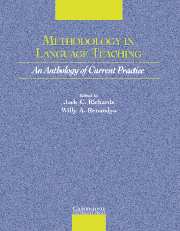Book contents
- Frontmatter
- Contents
- Acknowledgments
- Introduction
- Section I Approaches to Teaching
- Section 2 Lesson Planning and Classroom Management
- Section 3 Classroom Dynamics
- Section 4 Syllabus Design and Instructional Materials
- Section 5 Task and Project Work
- Section 6 Learning Strategies
- Section 7 Teaching Grammar
- Section 8 Teaching Pronunciation
- Section 9 Teaching Speaking
- Section 10 Teaching Listening
- Section 11 Teaching Vocabulary
- Section 12 Teaching Reading
- Section 13 Teaching Writing
- Section 14 Assessment
- Section 15 Technologies in the Classroom
- Section 16 Professional Development
- Credits
- Author Index
- Subject Index
Section 15 - Technologies in the Classroom
Published online by Cambridge University Press: 10 November 2010
- Frontmatter
- Contents
- Acknowledgments
- Introduction
- Section I Approaches to Teaching
- Section 2 Lesson Planning and Classroom Management
- Section 3 Classroom Dynamics
- Section 4 Syllabus Design and Instructional Materials
- Section 5 Task and Project Work
- Section 6 Learning Strategies
- Section 7 Teaching Grammar
- Section 8 Teaching Pronunciation
- Section 9 Teaching Speaking
- Section 10 Teaching Listening
- Section 11 Teaching Vocabulary
- Section 12 Teaching Reading
- Section 13 Teaching Writing
- Section 14 Assessment
- Section 15 Technologies in the Classroom
- Section 16 Professional Development
- Credits
- Author Index
- Subject Index
Summary
INTRODUCTION
The three articles in this section deal with the use of technologies in the classroom. In recent years, the use of technological aids, especially those related to computers, has increasingly become a common feature of the classroom. There is no doubt that computer-based instruction will occupy a more central role in the second language classroom in the future. However, as we eagerly explore the potential that this new technology has to offer to language learning, we should not lose sight of the fact that it is the teacher, not the technology, who determines the quality of the learning that takes place in the classroom.
In adopting a new technology, be it a tape recorder, a VCR, a CD-ROM multimedia, or other network-based communication technology, Jones and Sato (1998) suggest that we consider the following questions:
Does the new technology facilitate the attainment of course goals?
Is it cost-effective? Do the benefits outweigh its cost?
Are the teachers ready to work with the new technology? Is any training required?
Does it serve the needs of the teachers and students?
Does it help teachers make more efficient use of class time?
There are other questions to think about, but these are some of the most important questions that need to be addressed before we decide to implement new technologies in the classroom.
Stempleski discusses the positive features of video materials and presents guidelines which can help teachers plan their video lessons effectively.
Information
- Type
- Chapter
- Information
- Methodology in Language TeachingAn Anthology of Current Practice, pp. 361 - 363Publisher: Cambridge University PressPrint publication year: 2002
